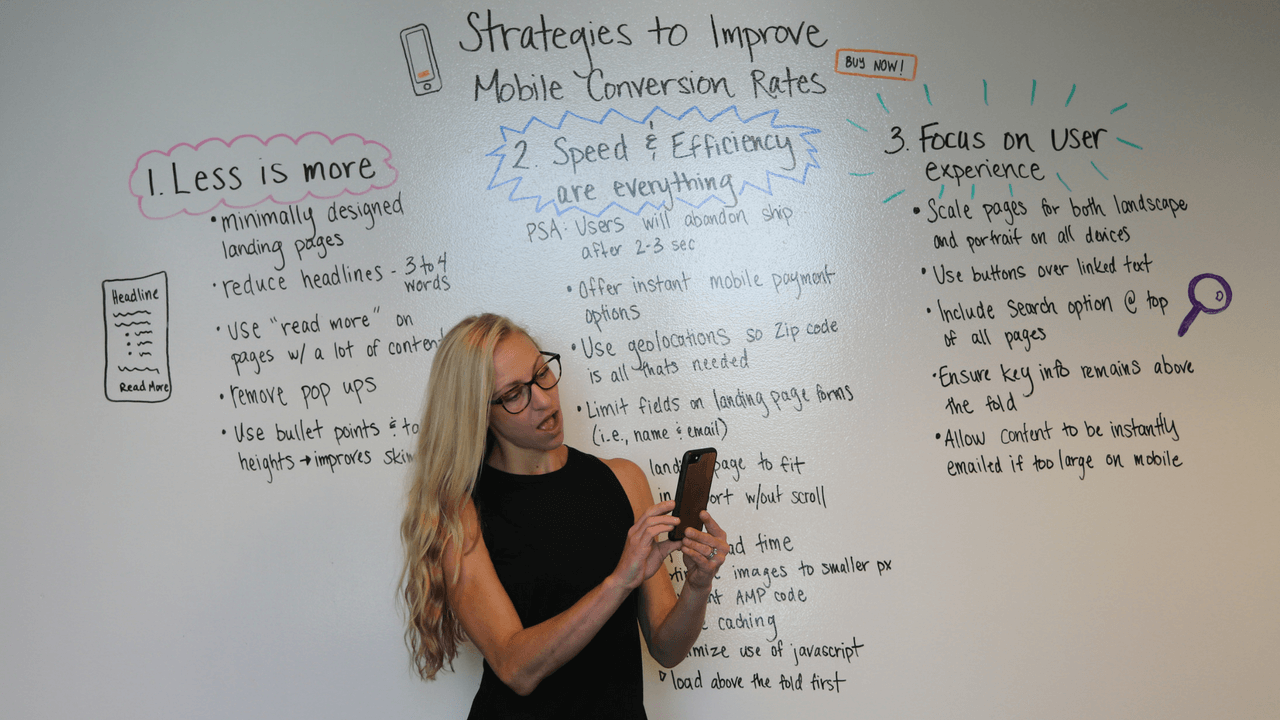Elevate your Lead Generation with CRO Marketing
In today's digital age, attracting website visitors is just the tip of the iceberg; the real challenge lies in converting those visitors into...
I know what I am looking for, and would like to chat.
A team of data-driven marketers obsessed with generating revenue for our clients.
Because the proof is in the pudding.
At Campaign Creators we live by three principles: Autonomy, Mastery, Purpose.
4 min read
![]() Tammy Duggan-Herd
:
6/8/18 9:53 AM
Tammy Duggan-Herd
:
6/8/18 9:53 AM

Converting visitors on your mobile webpage into customers can be a challenging process. In fact, mobile conversion rate optimization is one of the most misunderstood areas in digital marketing due to different customer motivations and intentions when using mobile devices versus traditional devices.
So whether you're a B2B SaaS business looking to get more trial sign-ups, an eCommerce store looking to improve your overall eCommerce marketing, here's how to ease the implementation of mobile CRO for your business and convert mobile visitors into leads.
Conversion Rate Optimization (CRO) is defined as a system for increasing the percentage of visitors to a website that convert into customers, or more generally, visitors that take any desired action on a webpage. Mobile CRO, on the other hand, refers to increasing the percent of users who take a desired action when viewing a mobile webpage.
The importance of mobile CRO has grown drastically over the last few years as mobile search and mobile commerce (M-Commerce) have become staples of everyday life for consumers. In fact, BI Intelligence has gone as far as to say that by 2020, mobile will compromise 45 percent of US E-Commerce. Up from just 11.6% in 2014. People who shop online using their mobile devices also tend to spend twice as much via digital channels than those not buying on mobile devices. Digital marketers are aware of this huge growth and are now trying to plan accordingly.
In the first quarter of 2016, the average smartphone conversion rate was just 1.3 percent compared to 4 percent for traditional E-Commerce. While it is a huge discrepancy, a large part of this difference is due to desktop being a mature channel that users are still more acclimated to, especially when it comes to E-Commerce.
Additionally, if we compare these conversion rates to the 2015 first quarter numbers (1.07 percent and 3.62 percent respectively), we see that the growth rate of mobile conversions was more than double that of traditional conversions which reflects the growing number of opportunities in mobile.
These conversion rates also don’t tell the complete truth about M-Commerce. According to Google, 85% of online shoppers start a purchase on one device and finish on another. Therefore, a multi-touch attribution model would better represent the overall impact mobile is making on conversion rates.
And it doesn’t end there. A recent study found that 88 percent of consumers who search for a type of local business on a mobile device call or go to that business within 24 hours. With almost half of in-store shoppers search for additional information on products or services while in-store.
This ability for mobile to affect not only its own conversions, but all areas of commerce is what makes it so important. If expert projections are correct, we can expect mobile CRO to become as, if not more, crucial as traditional conversion optimization in the near future.

The main difference between converting PC or laptop users and converting mobile users relates to the situations in which each medium is used. Typically, the purpose of a mobile query is to find immediate and relevant information on a product, service, or business. Desktop users on the other hand are usually browsing with a much less immediate intent.
Knowing this, optimizations of your mobile conversion rate should focus much more heavily on speed and efficiency than your traditional CRO solutions. They should also provide more specific, less bulky content that can be easily accessed through a mobile device.
All mobile CRO projects are fundamentally different and therefore require different strategies. The following is a list of tips and advice that should be taken into account when creating your strategy, regardless of the project.
No matter what aspect of a mobile website you are optimizing, less is always more. This concept will be the most important factor in every step of your mobile CRO efforts. Here are some suggestions on how to apply it:
It only takes extra 2-3 seconds for some mobile users to deem a process too long and abandon a site. Beyond just having minimal content on mobile web pages, there a few other ways to speed up the conversion process for users:
The ease of use and flow of your mobile website can make or break your mobile CRO. Mobile shoppers convert 160 percent more often on sites that are optimized for smartphones than on those that are not optimized for mobile.
As mentioned above, no two mobile CRO projects will be the same. Some of these items may not apply completely, or not at all, to your mobile website. But more often than not, if you want to capture the increasingly popular mobile shopper, including these strategies will set you apart from your competitors.
Conversion rate optimization is just one key tactic aimed at turning website visitors into leads and customers. For even more ways to boost your lead gen efforts get your free guide, The 30 Best Lead Generation Tips, Tricks and Tactics.
This blog post is part of Your Definitive Guide to Lead Nurturing blog series and Your Definitive Guide to Conversion Rate Optimization blog series.

In today's digital age, attracting website visitors is just the tip of the iceberg; the real challenge lies in converting those visitors into...

Research shows that in recent years the percentage of mobile internet traffic has been growing significantly all over the world. This trend is only...

Conversion rate optimization (CRO) is vital for the growth and success of any eCommerce business in today’s competitive online marketplace. With top...